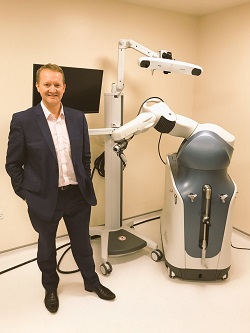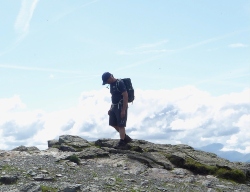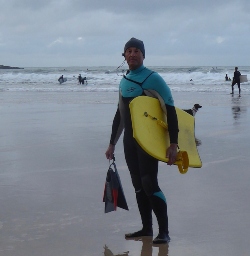Athlete returns to sport thanks to rare robotic-assisted double knee operation at Leeds Hospital - Ian's story
An athlete at a high level of sporting fitness has benefited from innovative technology at Nuffield Health Leeds Hospital meaning he can go back to the sport he loves following double knee replacement surgery.

Ian Purdy an energetic hill and mountain walker, windsurfer, cyclist, and squash player snapped his left knee cruciate, aged 28, whilst skiing, and had an ACL reconstruction when he was 35.
“Over the years I naturally protected my left knee by putting more effort into the right one whilst doing activities, especially walking off the mountains. However, I knew in the last five years that my left knee was losing its quality of operation, it would ache at night if I slept on my side but I put up with it. In the summer of 2019, whilst I was windsurfing, I felt something go in my ‘good’ knee - the right knee, and I could tell that it was not good, there was no great pain but a real loss of power.”
Ian says: “On seeing a couple of physiotherapists, they were reluctant on recommending knee replacements for someone relatively young. Alternatively, I was given a cortisone injection that gave me some relief but after four months it was wearing off.
“The physiotherapists were still reluctant to recommend getting my knees replaced but I was worried that the longer I left it, the more muscle condition I’m going to lose.
“Once the physiotherapists knew however I was going for the operation, the focus of their treatment was to plan a pre-op program to get my legs into the best condition.
“For me, my mental mind set became the more I put into building my legs up before the operation, the chance of a better result. I was prepared to put significant effort in before and after the event as for me: failure was not a possibility.

This mindset led Ian to start researching online and reading information which, initially was generic material that related to people whose knees had degenerated considerably, probably because they were older, less active, and overweight.
Not one to give up, he researched sports people who had had both knees replaced. Ian learnt a lot about people over 50 who had trained properly with a good technique and had knee replacements who were able to get back to the same levels of fitness. For Ian, it was a gamechanger he identified the need to find the right consultant that could give him his life back again and made an appointment to see Consultant Orthopaedic Surgeon Mr Jon Conroy.
“Mr Conroy was the real deal in terms of the information he gave me, and his manner of approach. It was obvious when he examined me that he recognised I was determined, capable, and serious in wanting back what I had before. It was great to find someone who could see the possibilities,” Ian said.
How robotic-assisted knee replacement surgery works

Following the consultation, Mr Conroy took the rare decision to replace both knees at the same time to give Ian the opportunity to strengthen his legs equally post operation. He then explained there were three main steps to robotic surgery.
The first step: preoperative planning. This involves a CT scan to look at the 3D position of the bone and the deformity in a patient’s knee. It identifies the amount of osteoarthritis whilst allowing the consultant to assess at whether there's any excessive bone that may need to be removed, the CT scan provides much more information than a standard X ray can.
A 3D model is created and using digital technology the image can be virtually rotated around a computer screen in all directions so the surgeon can envisage how the knee may move functionally. The benefit will be in the knee’s performance. The joint replacement can be assessed before any surgery is carried out so that the medical team can model what surgery to do.
“It allows us to choose the exact correct size for the patient, in some circumstances when we do knee replacements sometimes the surgeon can oversize the implant or put the implant in a slightly different rotation which may cause significant problems for patients post operation. This system allows us to get the correct size, and rotation as well as position the implant.
“It also allows us to make incisions around the bone that you can't do by hand. We can make slanted or curved incisions with a Burr that allows surgery that's not possible in the standard approach. This means we can correct deformities with minimal soft tissue released and by doing so those patients have less pain afterwards and recover quicker,” Mr Conroy said.
The second stage is during the operation. A surgeon can assess the soft tissue and the balance of the knee using the computer assisted robotic system. The knee is run through the natural bend that it should have, and the consultants work out how the knee would be balanced in the correct way. By assessing that and putting the information into the robotic system it allows the robot to make an incision in the bone in the optimal position.
“The robotic system used at Nuffield Health Leeds Hospital, is the most advanced robotic system for this type of procedure and has been in clinical use for well over 10 years. The majority of robotic assisted orthopaedic surgeries carried out worldwide are completed using this system.
“The robotic arm has a special blade and all the incisions in the different directions are made by the robotic system as opposed to other methods.”

“The advantage is that the blade system doesn't need as many retractors because as it makes the incisions to the bone, the robot knows where the bone ends therefore causing less soft tissue damage. The robotic system senses where the incision should be and where it should end. It can automatically cut power to the blade, so it doesn’t do any harm to the soft tissues, nerves or tendons, this is known as haptic control, it has a sensing system that knows exactly where it is, plus a safety mechanism.”
If there is less soft tissue damage, patients recover quicker.
The third stage is putting in the trial or temporary implant. This enables the surgeon to work out exactly how the knee may move once the patient has recovered from the surgery. The range of movement and balance of the knee is monitored. Then the real implants cemented in place, this is recorded so that the knee movement in the adequate or in the optimal position has full range of movement to reassure the patient that everything's just as good as it can be.
The benefits of robotic-assisted knee surgery
Patients are able, if they choose, to watch the surgery through monitors observing all the different steps as they go through the procedure. It gives them confidence.
“The robotic system has the ability to perform very accurate incisions of the bone which gives, in my opinion, much improved outcomes and speedier recovery with better long-term function.”
“The procedure that we use often sees a patient going home sometimes the same day or the following day after surgery. Patients may come off crutches more quickly, within two to four weeks. Not only do they benefit from a quicker recovery there is less swelling, and pain and we know from post operative X rays that the position of the implants is exceptionally good. Long term if the knee replacements are put in the accurate position they last longer and don't have excessive wear. If an implant is put in at the wrong angle it will wear out quicker,” Mr Conroy says.
Ian Purdy concurs: “I had both my knees done at the same time on 4th August 2020. I said to Mr Conroy I wanted to be windsurfing by Easter 2021. He thought that was a bit too ambitious, but I had a goal.

“Before my operation I had managed to cycle thousands of miles and I was fit, and I had done swimming with fins to bolster my knees and that made an enormous difference. The normal recovery is about six weeks before you can drive a car again but after 2.5 weeks the physiotherapists said I had enough control over my legs to drive. By October this year, that’s 12 -15 months’ post operation, I was doing exercise and I’m back to windsurfing, managing to do manoeuvres on my board, which is important as the body adjusts to compensate to keep the board in the water properly. I am also climbing steep mountains in Scotland. What Mr Conroy has done for me and understanding my background and needs has been truly life changing!”
Mr Conroy has been heavily involved in the hip replacement design for the Mako System; he adds: “from working in the USA to perfect a procedure that now has proven long term results as well as over 200 peer reviewed publications. This is in contrast to newly introduced robotic systems with currently limited functions and peer reviewed publications. The robot has been used at Nuffield Health Leeds Hospital, since 2017, making it the first hospital in England, to use it north of London.”
Mr Conroy instructs fellow surgeons in Amsterdam for Europe and Taiwan for the Chinese and Japanese markets. He says: “As the first to install it in the north of England our unit at Nuffield Health Leeds Hospital has pioneered orthopaedic robotics across total knee replacement, uni-compartment or partial knee replacement and total hip replacement. We are consistently in the top performing units for robotic joint replacements across the country including my own personal experience of over 700 cases.”
